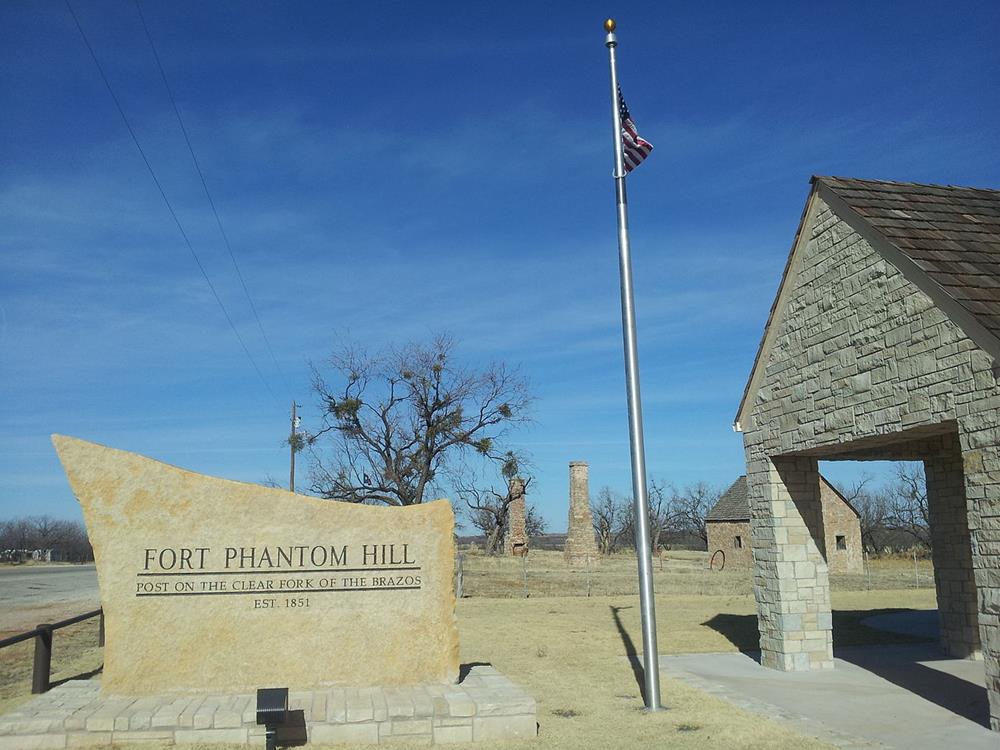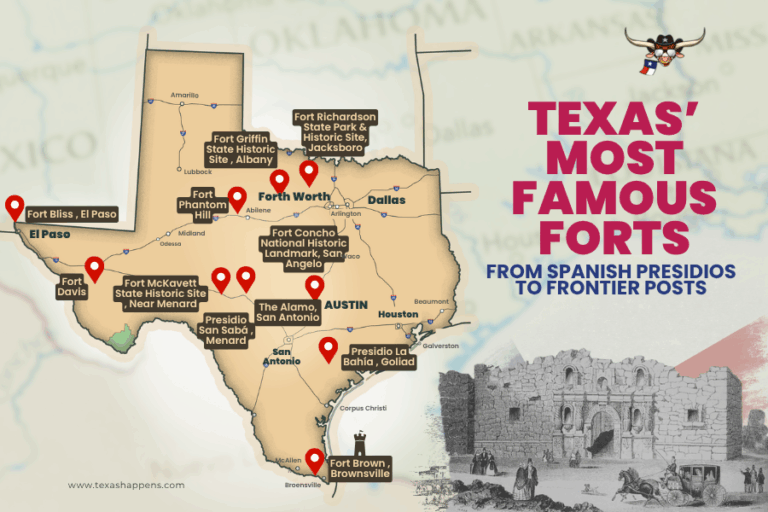Texas’ fort story stretches from Spanish colonial missions to U.S. Army posts that protected stage routes, railheads, and nascent towns. Some sites are global icons (hello, Alamo); others are windswept ruins whose stone walls and lonely chimneys still frame the big Texas sky. Use this guide to understand why these places matter—and how to weave them into a memorable road trip.
How Texas Built Its Defense Network
Before the U.S. Army ever marched across the prairie, Spain established a chain of missions and presidios. Missions evangelized and settled; presidios provided the military protection. In the 19th century, the United States layered on a new system of frontier posts—open-plan complexes around a parade ground, with barracks, a hospital, a guardhouse, stables, and officer quarters. These outposts escorted mail coaches and wagon trains, patrolled vast corridors like the San Antonio–El Paso Road, and, over time, seeded many Texas communities.
Spanish Presidios & Mission Forts
View this post on Instagram
The Alamo (Mission San Antonio de Valero) — San Antonio
Originally founded as a mission in the early 1700s and later used as a military post, the Alamo became the most famous symbol of Texas independence after the 1836 siege and battle.
Inside the complex you’ll see the mission-era church and interpretive exhibits that trace both the site’s Spanish beginnings and its Texas-Revolution legacy. It’s also part of the San Antonio Missions group recognized for their global cultural value.
Expect crowds, but also expect goosebumps: this is one of those rare places where world history and local identity intersect.
Why it’s famous: Mission-to-fort evolution; pivotal 1836 battle; enduring “Remember the Alamo” legacy.
Plan for: 60–120 minutes, more with nearby missions.
Presidio La Bahía — Goliad
This 18th-century Spanish presidio guarded the coastal corridor and later figured heavily in the Texas Revolution. Its chapel and thick walls feel like a time machine; exhibits explain the presidio system, the colony at Goliad, and the events that made “Goliad” a solemn name in Texas memory.
Why it’s famous: One of the best-preserved Spanish military sites in the state; critical Revolutionary history.
Plan for: 60–90 minutes.
Presidio San Sabá — Menard
Built in the 1750s to protect nearby missions on the San Saba River, this presidio sat on the very edge of Spain’s northern frontier. Today, stabilized ruins and interpretive panels lay out a story of ambition, fragile alliances, and the harsh realities of the borderlands.
Why it’s famous: Spanish frontier experiment in a perilous landscape.
Plan for: 45–60 minutes.
Frontier Army Forts (1848–1890s)

Fort Davis National Historic Site — Fort Davis
Set in the shadow of the Davis Mountains, Fort Davis guarded the San Antonio–El Paso Road and the Chihuahua Trail. It’s one of the best-preserved posts in the American Southwest. Barracks, officer’s quarters, a restored commissary, and walking trails bring to life the daily rhythm of a frontier garrison. The story here is inseparable from the Buffalo Soldiers—Black regiments who patrolled the Trans-Pecos and escorted travelers across harsh, stunning terrain.
Why it’s famous: Exceptional preservation; mountain setting; Buffalo Soldier history.
Plan for: 2–3 hours, plus time for nearby hikes.
Fort Concho National Historic Landmark — San Angelo
Built of local limestone at the confluence of the Concho Rivers, this post anchored Army operations across the Edwards Plateau and Pecos country. Today’s complex includes a row of handsome stone buildings around the parade ground, a first-rate museum, and frequent living-history weekends where cavalry tack, rifles, and bugle calls return to the field.
Why it’s famous: Landmark preservation; strong museum and programs.
Plan for: 2–3 hours.
Fort Richardson State Park & Historic Site — Jacksboro
On the northern line of post-Civil War forts, Richardson protected the approaches to the Cross Timbers and the Southern Plains. Surviving buildings—including the substantial sandstone hospital—show frontier medicine and the realities of a working post. Trails and a small lake round out a relaxed visit.
Why it’s famous: Intact hospital and barracks; good introduction to Texas’ “line of forts.”
Plan for: 90 minutes–2 hours; more if you hike.
Fort Griffin State Historic Site — Albany
Perched above the Clear Fork of the Brazos, Fort Griffin helped police a volatile frontier in the late 1860s–70s. The fort is known for its evocative ruins and for the nearby “Flat,” a boisterous settlement that drew lawmen, drovers, and drifters riding the great cattle trails. Today, the site interprets the post’s military role and the sometimes-rowdy culture orbiting it.
Why it’s famous: Frontier outpost tied to trail-drive lore and law-and-order legends.
Plan for: 60–90 minutes.
Fort McKavett State Historic Site — Near Menard
Fort McKavett’s limestone buildings and big-sky setting offer one of the most photogenic fort experiences in Texas. From the parade ground you can picture drill, guard mount, and prairie wind flattening the grass. Exhibits cover soldiers’ routines and campaigns, including service by Black regiments.
Why it’s famous: Remarkable setting and masonry; classic parade-ground layout.
Plan for: 60–90 minutes.
Fort Phantom Hill — Abilene Area
Short-lived as an Army post (1851–1854), Phantom Hill rose again as a crucial stop on the Butterfield Overland Mail route (1858–1861). Today, iconic brick chimneys and stone ruins stand out against the prairie, making it one of the most atmospheric sites on the trail.
Why it’s famous: Signature skyline of standing chimneys; stage line history.
Plan for: 45–60 minutes.
Fort Lancaster State Historic Site — Near Ozona
This post guarded the Pecos crossing and protected travelers on the San Antonio–El Paso Road. You’ll find low stone walls mapping the footprint of barracks, kitchens, and storerooms; the emptiness is part of the power here. The site also interprets skirmishes and supply challenges faced by 19th-century troops in a remote river valley.
Why it’s famous: Guardian of a vital overland corridor; evocative ruins.
Plan for: 60–90 minutes.
Fort Chadbourne — North of San Angelo
Established in 1852, Chadbourne protected central-west Texas routes and later hosted a Butterfield stage station. A private foundation has restored key structures and assembled an impressive artifact collection. You’ll come away with a feel for mail-coach logistics and day-to-day soldiering in an exposed landscape.
Why it’s famous: Butterfield stage station and strong on-site collections.
Plan for: 90 minutes–2 hours
Border & Civil War Forts
Fort Brown — Brownsville
Built during the U.S.–Mexico War (and later rebuilt), Fort Brown anchored the lower Rio Grande. The area played a role in the Civil War and Reconstruction; nearby Palmito Ranch is often cited as the last land battle of the Civil War, fought in May 1865—weeks after Appomattox. Much of the post has been absorbed by modern development, but earthworks and historic structures still tell the tale of a strategic river crossing and a city that grew up around it.
Why it’s famous: Border stronghold; proximity to the Civil War’s final land battle.
Plan for: 60–90 minutes (museum and grounds vary by season).
Modern Army Posts with 19th-Century Roots
View this post on Instagram
Fort Sam Houston — San Antonio
The Army has been in San Antonio since the 1840s, but the post’s signature Quadrangle dates to the late 1870s. Fort Sam Houston is a striking masonry complex that still anchors the installation. History buffs know it for a unique footnote: in 1886, Geronimo was held briefly within the Quadrangle after his surrender. Today, museum exhibits and the architecture itself trace the evolution from frontier post to modern medical and training hub.
Why it’s famous: Architecturally significant Quadrangle; deep continuity of Army presence; Geronimo episode.
Plan for: 60–90 minutes, subject to base access rules.
Fort Bliss — El Paso
One of America’s largest Army installations, Fort Bliss began as a mid-19th century border post and grew with the railroad, aviation, and missile eras. While the modern mission dominates, heritage exhibits and historic structures connect visitors to the older layers of El Paso’s military story.
Why it’s famous: Scale and longevity; a living post with 19th-century origins.
Plan for: 60–90 minutes, subject to base access rules.
Plan Your Texas Forts Trail Road Trip
How long: A great loop through the Texas Forts Trail Region runs 3–5 days, depending on how many sites you enter and how often you linger.
Sample loop (west/central focus):
Day 1: Fort Richardson → Fort Phantom Hill → overnight in Abilene
Day 2: Fort Chadbourne → Fort Concho → overnight in San Angelo
Day 3: Fort McKavett → Presidio San Sabá ruins → overnight in Menard/Junction
Day 4: Fort Lancaster → long scenic drive to Fort Davis → overnight in Fort Davis/Alpine
Day 5: Fort Davis National Historic Site → Fort Griffin on the return leg (or continue to El Paso for Fort Bliss)
Best seasons: Fall through spring are ideal for West Texas and plateau sites. Summer is doable—start early, hydrate, and expect big heat.
How much time at each fort:
- Major sites with museums/living history (Fort Davis, Fort Concho): 2–3 hours
- Ruins and smaller sites (Phantom Hill, Lancaster, San Sabá): 45–90 minutes
- Urban and border posts (Alamo, Fort Brown, Fort Sam Houston): 1–2 hours (longer for the Alamo area)
What to bring: Water, sun protection, closed-toe shoes, and a sense of curiosity. Many sites have uneven ground; shade can be limited. Check hours before you roll—programming and access may vary by season.
FAQs
What’s the difference between a mission, presidio, and fort?
A mission was a religious and settlement center; a presidio was its Spanish military counterpart. A U.S. Army fort was typically a 19th-century post with an open parade ground and separate buildings for barracks, hospital, officer housing, and supply—more campus than castle.
Which Texas forts are the best preserved?
Fort Davis (spectacular setting and restored buildings) and Fort Concho (extensive limestone structures and museum) are standouts. Fort Richardson retains substantial buildings, and The Alamo presents both mission and military layers. Others—Fort Phantom Hill and Fort Lancaster—shine through their evocative ruins and landscapes.
Where can I learn about the Buffalo Soldiers in Texas?
Fort Davis interprets the service of the 9th and 10th Cavalry and 24th and 25th Infantry. Several other posts—Concho, McKavett, Richardson—also discuss Black regiments who served on the Texas frontier.
Is the 360 Bridge overlook part of a fort?
No. The Pennybacker (Loop 360) Bridge viewpoint is a popular Austin overlook unrelated to Texas forts. For mission-era history in Austin, visit sites associated with the city’s early settlers; the main mission-presidio chains are concentrated farther south and west.
How do base access rules work for active posts like Fort Sam Houston or Fort Bliss?
Access policies change. Bring government-issued photo ID, and be prepared to check in at a visitor center. If you prefer guaranteed entry, focus on the state historic sites, national parks, and city museums listed above.


